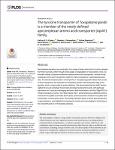The tyrosine transporter of Toxoplasma gondii is a member of the newly defined apicomplexan amino acid transporter (ApiAT) family
Parker, Kathryn E. R.
Fairweather, Stephen J.
Rajendran, Esther
Blume, Martin
McConville, Malcolm J.
Bröer, Stefan
Kirk, Kiaran
van Dooren, Giel G.
Apicomplexan parasites are auxotrophic for a range of amino acids which must be salvaged from their host cells, either through direct uptake or degradation of host proteins. Here, we describe a family of plasma membrane-localized amino acid transporters, termed the Apicomplexan Amino acid Transporters (ApiATs), that are ubiquitous in apicomplexan parasites. Functional characterization of the ApiATs of Toxoplasma gondii indicate that several of these transporters are important for intracellular growth of the tachyzoite stage of the parasite, which is responsible for acute infections. We demonstrate that the ApiAT protein TgApiAT5-3 is an exchanger for aromatic and large neutral amino acids, with particular importance for L-tyrosine scavenging and amino acid homeostasis, and that TgApiAT5-3 is critical for parasite virulence. Our data indicate that T. gondii expresses additional proteins involved in the uptake of aromatic amino acids, and we present a model for the uptake and homeostasis of these amino acids. Our findings identify a family of amino acid transporters in apicomplexans, and highlight the importance of amino acid scavenging for the biology of this important phylum of intracellular parasites.
Dateien zu dieser Publikation

